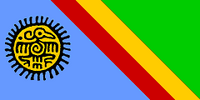Mejico

| |
| Languages: | |
| Official: | Nahuatl, Castilian |
| Others: | Felipese, other native languages |
| Cities: | |
| Capital: | Tenochtitlán (Altepetl Mexihco, Ciudad de Méjico) |
| Largest: | Ciudad de Méjico |
| Other: | Guadalajara, Monterrey, Puebla, Toluca, Ciudad Juárez, León, Veracruz |
| Monarch: | Cuautémoc VI |
| President of the Senate: | Vicente Lobo-Martiz |
| Independence: | from Castile and Leon |
| Declared: | 1822 |
| Recognized: | 1828 |
| Organizations: | none. Applying to: Castilian Commonwealth and the Andean Pact Formerly: CELCAGOM |
The Empire of Mejico is a large North American country situated south of the Kingdom of Tejas and the Republic of Alta California, north of the Central American Community.
Administration
Government
Mejico is a constitutional monarchy, despite the "Republic" in its name.
The Head of State is an hereditary monarch with limited political power. The current monarch is Cuautémoc VI.
The regime is presidentialist with the Chief of Government, called "President", elected by popular vote.
The legislative is formed by a tricameral parliament. The three chambers: the House of Elders, the Senate, and the Chamber of Representatives, form together the Mejican Congress.
Administrative Divisions
History
The heartland of Mejico was populated by Nahuatl speaking Mexica peoples who by 1500 had been organized in an empire, known as the Aztecs.
Castilian Hernán Cortés conquered the Aztec empire and established the Castilian rule over Mejico. Soon Mejico became the center of the Viceroyalty of New Leon up till 1822. New Leon compised also Tejas, Alta California, Central America, and Filipinas.
In 1818, the Viceroyalty of New Leon became dependant of the Great Viceroyalty of the Overseas, ruled by Prince Carlos. The reduction of the power and a longer administrative way to Valladolid lead to resentment of the Criollo elite. The strugle between the Carlists and the Mejican aristocracy permited native insurrection, which took control of Mejico City in 1822, declaring a new and independent Mejican kingdom.
The new Mejican government had theoretical claims over the whole New Leon, or at least over the continental part of it, but was still weak to support this claims and passed the following years consolidating their power in Mejico proper. Meanwhile several criollos had moved to Tejas and New Mejico.
In 1828, Castile recognized the independence of Mejico, but not their claims over Tejas, California and Central America. By this time the Mexicas had a fairly stable government in Mejico and begun letting some loyal criollos into the administration. The Mejicans also begun securing the territories of Arizona and New Mejico, and attempted to overturn the independence of Tejas.
California declared independence in 1834 from both Castile-Leon and Mejico. By this time Mejico had a much stronger army and even a navy, and constested this declaration with a full invasion of California, as California quickly surrendered, Mejico invaded Central America.
In 1836, the Central American war between Castile-Leon and Mejico was over, Guatemala confirmed as part of Castile-Leon, and Yucatan confirmed as part of Mejico. Castile and Leon also compromised on no intervensions over Tejas and California.
However, tensions between the Nativist government and the still strong Criollo aristocracy broke down into a civil war thar would last from 1838 to 1854. During this period, Mejico lost all its territories north of the Rio Grande due to the local populace's discontent with the warring factions in the south. Alta California fought for its independance, and after achieving it invaded Baja California and Arizona. Tejas consolidated, expanded and annexed New Mejico. Montrei was also formed, breaking appart from a too local government in Alta California. Chiapas also declared independence and opted for a protectorate status by Castile and Leon.
In 1854, a truce was signed between the two main surviving fractions: the Nativists and the Castilianists. The Castilianists would recognize the Nativist leader as Head of State under the title of king, while the chief of government would be elected from among the criollos for a transitional period of 25 years (five terms). This was only briefly interrupted in 1861 when Napoleon III invaded to collect on debts owed to France. In 1864, he established Emperor Maximilian I, who ruled until 1867, when he was captured by Mejican nationalist troops, and was executed. Benito Juarez ruled through that time as chief of government throughout the period of the war. Main Article: Franco-Austrian Mexican Adventure.
Once the 25 year period completed, the restrictions over who could run for president ended. Since the turnover period, in 1880, most presidents have been of Castilian origin.
Currently, the country is embroiled in an elections scandal sparked by the ballot box stuffing candidate Vicente Lobo-Martiz (1998). Economically, the country is in shambles (suffering from hyperinflation and regularly devalued currency); though Lobo-Martiz has promised to reform the economy.
Mejico has been the big winner in the recent 2003 War with Tejas over the invasion of Alta California by one time Tejan strongman Jorge Bush. The hero of the day is undoubtedly president Vicente Lobo-Martiz who has done much to begin the rehabilitation of Tejas, in expectation of the (now delayed) coronation of the heir to the Tejan throne. The coronation which was set for 1 July, has been relocated to 1 August.
Geography
Borders
North: Tejas.
Northwest: Alta California.
South and Southwest: Pacific Ocean.
Southeast: Central American Community and Belice.
East: Gulf of Mejico.
Culture
Languages
Most of the population speaks Nahuatl, the descendent of the language of the Aztecs. The rest of the population speaks either Castilian, other native languages or, in the northeast, Felipese.
Both Nahuatl and Castilian are equal under the law, and most people know both languages (although native Nahuatl speakers generally know Castilian better than native Castilian speakers know Nahuatl).
Religion
Catholocism is practiced by the overwhelming majority of the population. There are a few modern converts to other denominations and a small number of Muslims in the northeast among the Felipese.